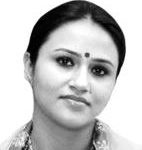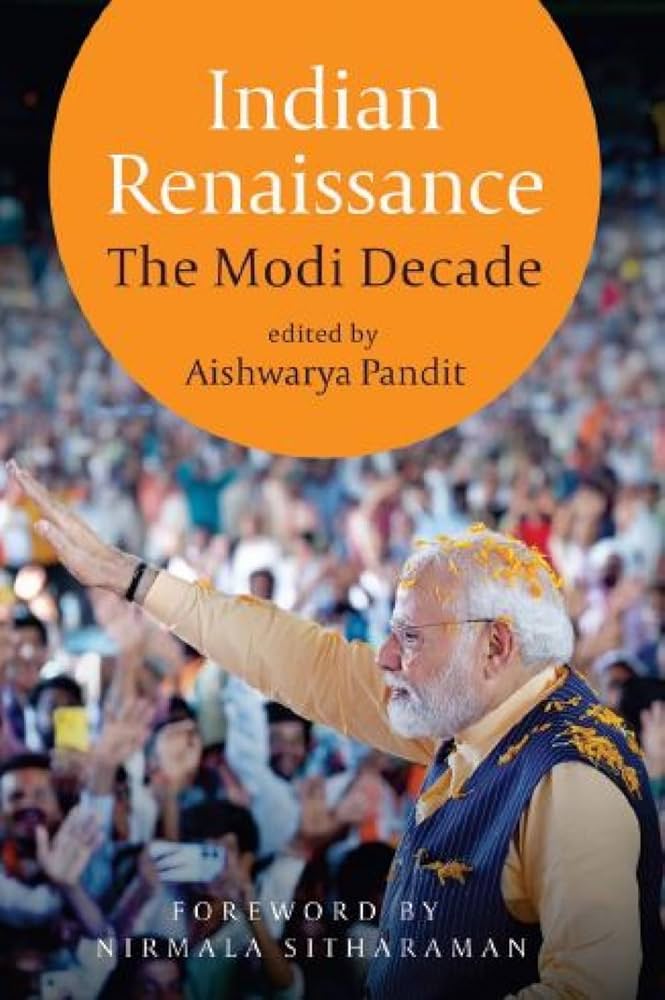The Modi Dynamism
How the prime minister dismantled one legacy and built another
 Aishwarya Pandit
Aishwarya Pandit
 Aishwarya Pandit
|
05 Aug, 2024
Aishwarya Pandit
|
05 Aug, 2024

/wp-content/uploads/2024/02/Whitepaper1.jpg)
Prime Minister Narendra Modi (Photo: AFP)
Legacy is a peculiar word. It is often used to discuss political dynasties, political parties, family-run businesses and even media entities across the world. Cambridge Dictionary defines legacy as ‘money or property that you receive from someone after they die.’ Social, political, spiritual and, most importantly, economic legacy is passed by our parents to us as inheritance. Then there is the legacy of the Colonial Raj, which we, the children of modern India, have to contend with even today—we are still living with the physical, social and cultural remnants of the Raj. Of all legacies, it is political legacy that we focus on.
Since the 1950s, critics of Indian democracy have often made predictions about its eventual demise or the fracturing of the social fabric of India. This cynicism is a legacy of the Colonial Raj and continues to haunt political and intellectual discussions even today. The British had the implicit belief that if they left, India would splinter into many halves. This cynicism remained a constant refrain of people of different hues even after Independence. Any attempt at embracing our cultural identity has critics up in arms. They portray it as the secular fabric being in danger of annihilation. However, it is not our secular fabric that is in danger but our cultural identity steeped in our collective pasts.
At the base of the Indian democracy lies its resilience, which was forged during the freedom struggle and remains its most defining feature. Narendra Damodardas Modi, the current prime minister of India, unlike his predecessors Jawaharlal Nehru, Indira Gandhi, Lal Bahadur Shastri, Rajiv Gandhi and PV Narasimha Rao, is not a product of Nehruvian consensus. Neither is he is an inheritor of legacy that represented many of his predecessors such as Lal Bahadur Shastri, Morarji Desai, Chandra Shekhar, PV Narasimha Rao or even Atal Bihari Vajpayee. With the exception of Vajpayee, all of them were a product of the ‘Congress system’ in one form or the other, whether directly or indirectly. This system, as defined by historian Rajni Kothari, represented a broad consensus that prevailed until the 1970s.’ In contrast is PM Modi, a man not given to cynicism and one who doesn’t believe in abandoning his identity. He has a strong sense of cultural pride, which draws heavily from India’s civilisational past. But it is important to understand the background behind the transformation of the cultural, social and political fabric of the nation under PM Modi’s leadership.
The 1990s can at best be described as a volatile decade, which witnessed frequent collapses of central and state governments, resulting in political instability. However, the economic liberalisation of 1991 was a pivotal moment that unshackled the economy and changed the course of history. The years between 2004 and 2014 were a mixed bag, and by the end of the decade people grew tired of policy paralysis and of the political class that was steeped in corruption. In contrast, while the period after 2014—or the Modi era—evokes strong reactions on either side of the political spectrum, few can deny the many changes introduced in this last decade that have had a lasting impact.
A quick research on global developments since 2014 led me to ten events with interesting revelations. In addition to the rise of ISIS, the disappearance of Malaysia Airlines flight 370 and the outbreak of Ebola, some websites listed ‘Narendra Modi wins in India’ as a noteworthy development of the period. Writing about the 2014-24 decade under PM Modi is a daunting task. Thinking of reference points for the decade or the persona of the prime minister is a complex task as comparisons are inevitable. During my research and interviews I thought about a term or description that would at best describe PM Modi—for, in India, there is a culture of prime ministers having popular nomenclatures that eventually find themselves as part of folklore. For instance, the political scientist Vinay Sitapati refers to former prime minister PV Narsimha Rao aptly as ‘half lion’; Sanjaya Baru has referred to Manmohan Singh as ‘the accidental prime minister’; Indira Gandhi has been famously called Durga, a personification of the mother goddess; and Atal Bihari Vajpayee as a consensus PM. With Modi, I would like to make a departure, as reducing the man to one word would not describe him or his tenure effectively. This is because he constantly reinvents himself such that historians like myself find it difficult to slot him. Such has been the nature of his evolution from the chief minister of Gujarat to the Prime Minister of India that his transformation has been mapped on the covers of popular magazines like India Today. One cover aptly described him as ‘the Modi machine’, a reference to his ability to be in election mode constantly; another used the word ‘Moditva’, which is a slight modification of the term ‘Hindutva’; a cover used the term ‘game-changer’ to describe him, and this is possibly the closest one can get to describing the almost two decades of Modi’s state and national politics. On 8 May 2014, an article in The Guardian referred to Narendra Modi’s election victory as another tryst with destiny. It argued that Modi’s victory marks the end of a long era in which the structures of power were not very different from the ones that Britain used to rule over the subcontinent. The article was almost prophetic in its announcement that Modi was going to dismantle many legacies—colonial, political, socioeconomic and, most importantly, the cultural legacy of the earlier period. Now a decade into his prime ministership, PM Modi has ushered in an India that warrants rediscovery.
Modi has turned the BJP into an electoral machine, leaving an imprint so deep that it rivals the scale of transformation achieved by his predecessor Jawaharlal Nehru. In the 1950s, Nehru commanded his party and the government with equal ease, especially after the 1952 elections when he became the undisputed leader of his party and the government. Congress emerged as an electoral machine under his daughter, Indira Gandhi, who began her first stint as the Prime Minister of India in 1966. You could disagree with Nehru, as many of his colleagues and historians like me do, even today. The case of PM Modi is no different. Some like to call him a disruptor; others see him as a rank outsider. However, neither his critics nor those who are in awe of him can deny that his years in the government have been transformational for the social, political and economic fabric of India. It is important to understand the transformational aspects of the Modi governments, as some argue that all prime ministers before him have brought significant changes since Independence.
Sanjaya Baru sees the former prime minister PV Narasimha Rao as truly transformational. Rao had inherited a bad economic situation but went on to lead India’s economic liberalisation. His decision to open the Indian economy is still seen as one of the most transformational feats achieved in independent India. What made it even more significant was that PM Rao never commanded a complete control of his party, had a fractious relationship with the Congress president Sonia Gandhi and headed a minority government. Unlike his predecessor Indira Gandhi, Rao didn’t have the advantage of the enduring legacy of being Nehru’s offspring. He was not mentored by Nehru while in office, nor did he serve as the official host, which would have exposed him to the nuances of international diplomacy and delicate domestic issues much before occupying office as prime minister. Indira Gandhi, on the other hand, was privy to the fact that her father subordinated the Congress party to the Congress government, and after the 1950 presidential election himself became the party president. This template was unique, an advantage that few prime ministers had. Some faced tough tasks as they headed unsteady coalitions in the 1990s. However, the commonality of all their tenures was their origins in the Congress system. They were all primary members of the Congress party early on in their careers and emerged as anti-establishment heroes, fighting the very system that had failed to realise their aspirations.
The case of Modi is markedly different. He is not, and has never been, a part of the Congress system so he doesn’t share any kind of emotional appeal with it. Moreover, whether it is domestic issues or foreign policy, Modi has evolved his own doctrine, which is very different from that of his predecessors. The most significant aspect is his ability to evolve in response to every situation, which comes from his vast administrative experience from his early years as an RSS functionary who worked his way up the organisation and the BJP, and later as the chief minister of Gujarat. Neither has he allowed his ideological leanings to overshadow pragmatic considerations while dealing with powerful regional leaders and international heads of state. His foreign policy and global outreach to the Indian diaspora was an untapped area, which he harnessed extensively, to create more diasporic involvement not only in India but globally. None of his predecessors enjoyed this scale of engagement with the Indian diaspora, which has elevated India’s position abroad and made every Indian interested in foreign policy—something that was earlier relegated to foreign policy experts and officials. Indians are, on the whole, conscious of how they are perceived globally as a community. Take the case of PM Modi’s visits to Australia and the US in 2023 where the Indian diaspora was at the forefront of the reception he received.
On domestic issues, PM Modi has not been shy to highlight what he perceives as domestic and international ‘blunders’, stemming from the Congress system, which he believes favoured the status quo. Like US President Harry S Truman, the architect of the Truman Doctrine, which ended an era of isolationism in US foreign policy post World War II, Modi has rejected the concept of non-alignment and propounded an ‘India first’ foreign policy where Indian strategic and economic interests are supreme and Indian foreign policy would service these needs. He saw that the non-committal stance adopted by India earlier vis-a-vis its position on global matters hindered her interests and reduced her to being a non-playing captain globally. Recently, despite criticism of remaining ambivalent in the light of the Israel-Palestine conflict, Modi has pursued the ‘nation first’ policy, putting India’s interests ahead despite there being pressure to support or condemn one of the parties to the conflict. Modi prefers to walk the tight rope rather than giving into the pressure to react, an issue that brought down the Manmohan Singh government. The Modi government has rejected a Eurocentric or Western world-view on international affairs and is focused on improving the reception India gets in the world, especially the Global South. The conviction to take the controversial decision to purchase Russian oil, a decision that was dictated by domestic energy needs, while maintaining a delicate balance with the US has largely been the result of practical considerations rather than pandering to any lobby. These moves have largely been possible and acceptable due to the fact that, unlike Narasimha Rao and Manmohan Singh, Modi represents mass opinion. Rao and Singh had to contend with the fact that they were not mass leaders by any stretch of imagination and depended on their party for acceptability. One of the lasting memories of Manmohan Singh’s first term in office was that his government nearly fell because of the Left parties’ decision to not support the nuclear deal that the prime minister viewed as necessary at the time for India’s long-term energy needs. Manmohan Singh, like many before him, was exposed to the vagaries of coalition politics early on—something that Modi doesn’t have to contend with. This has often invited the charge of critics that Modi is a dominant leader not given to consensus-building either with other political parties or within his own party. Modi has ensured that he is not the compromise choice of his party. This was not the case for Rao.
While Modi draws his strength from his party, he has also shared power with regional leaders within his party. There are several instances of this, including Shivraj Singh Chouhan, former chief minister of Madhya Pradesh; Vasundhra Raje Scindia, former chief minister of Rajasthan; and Yogi Adityanath, the current chief minister of Uttar Pradesh. When it comes to central leadership, Modi has shared power with Rajnath Singh, Amit Shah and Nitin Gadkari. In contrast, there was a lack of mass leaders after the death of Mukherjee and Upadhyay, who were still acquiring mass appeal before their untimely deaths, and before the rise of Vajpayee and Advani. The recent decision to make members of parliament and even ministers from the states of Madhya Pradesh, Chhattisgarh and Rajasthan contest state elections is largely dictated by this need to increase accountability of elected representatives, as well as to enthuse new blood into the party leadership. The comfort with which PM Modi deals with rumour-mongering about the future, with his possible successors being ready while he is in office, points to his being a secure leader. In this context, Modi is vastly different from Indira Gandhi, who was known to dismiss, replace and destroy any talk of successor or signs of succession.
One of the fundamental problems that the Congress party has to contend with today is the lack of any serious regional leaders with a mass base. Congress leaders like HN Bahuguna were sidelined by the party in the 1980s, former chief minister Sheila Dikshit was sidelined after her term ended, former chief minister of Punjab Amarinder Singh was sidelined while in office and state congress leaders with a mass base are being shunted out the party periodically even today. As Ramachandra Guha writes in his book Democracy and Dissenters, in the years after Indira Gandhi became prime minister, she had little sustained interaction with senior Congressmen. Here, I would like to make a necessary and important observation. Every time election results were announced since 2014, the prime minister has always visited the central party headquarters (earlier on Ashoka Road and now on Deendayal Upadhyay Marg) to congratulate and interact with his karyakartas. His messaging is clear; he is speaking directly to his cadres who form the backbone of the party. Modi has communicated that the party comes first. He reinforces it every time he visits the party office, reminding the workers that no matter how complete and stupendous a victory you may achieve, no individual—not even him, despite being the prime minister—is higher than the party. This is the enduring legacy he will leave behind: strengthening not only the party but the belief that the party is supreme.
In his speech to party cadres after the election victory in 2019, he said, ‘We the workers of BJP, our friends in NDA we dedicate the victory in the feet of the people…. Just like what our president [Amit Shah] said, the crores of BJP workers, their efforts and the purpose, I feel so proud that my party that I am a part of are full of generous people…. We have to accept the election results with humility. A government is formed with people’s mandate we have to work with the spirit of inclusion.’
Modi had inherited a BJP with no clear vision; a party unable to recover from the debacle of 2009. The loss had demoralised cadres—and more so the RSS, which many believe decided to fully back the then chief minister of Gujarat, Narendra Modi. Vinay Sitapati argues in his book that prior to 2004, Vajpayee and Advani’s reluctance to impose their party agenda was probably why almost no Hindutva causes made their way into law under the Janata government. With Advani at the helm, the 1990s were seen as the golden era of the BJP, and the Rath Yatra for building the Ram Temple culminated in expanding the BJP’s limited social base. Modi was a protégé of Advani and a young RSS functionary at the time. While the BJP vote share jumped from a mere 9 per cent and two seats in the 1984 general elections to 11 per cent and eighty-six seats five years later, and to 117 seats in 1991, a BJP government still seemed like a distant dream, if not impossible. One of the reasons for this was that, despite its tremendous success, the BJP remained confined to an upper-caste support base and failed to expand and reach out to lower castes and minorities. This led to the party being forced into coalitions with secularist state parties, thereby compromising its ideological foundations and succumbing to the pressures of coalition politics.
Sitapati argues that, even in 2004, BJP’s manifesto document did not stress on Article 370 or the Ram Temple; rather it was titled ‘An Agenda for Development, Good Governance and Peace’. Moreover, as Swapan Dasgupta says, Advani was on tour for ‘India Shining’ whereas there was no clear planning and what many saw as the dilution of ideology. So, Modi has walked a tight rope between balancing the institutional arm of the BJP with its electoral wing—a balance that Nehru struggled to establish within the Congress and which contributed to the decay of the organisation in the 1970s and 1980s. The BJP is also facing one of the biggest challenges today with the entry of outsiders who are seen with alarm by many within the BJP. The cadres need to be assured from time to time that they will be rewarded as, after all, it was they who suffered the most fighting the Congress on the streets in its heydays. The defection of leaders between parties has been a common practice since the time of Indira Gandhi and has continued ever since. Another challenge is that the cadre, for the first time, has seen such complete power, with the BJP and its allies being in power in more than sixteen states. This makes it imperative to insulate the cadres and leaders within the party from the problems associated with power. MS Golwalkar or Guruji, the charismatic Sarsanghchalak of the RSS, the ideological parent of the BJP, warned of the dangers of dilution of ideology and the challenge it would pose for the organisation. Modi, a pracharak himself, is conscious of these challenges, as the recent selection of old BJP hands as Rajya Sabha candidates from states suggests. The majority of Rajya Sabha candidates are party workers who have worked at the ground level for years. Multiple re-nominations for any individual come at the cost of opportunities for others.
Fighting the battle of perception had been a monumental task before the prime minister as the BJP was seen as an ideological party with little to offer to expand its base beyond urban voters in small towns and capital cities in India. This was a daunting task as leaders before him were tied up with a limited support base and had to contend with coalition partners, which nearly brought down governments. Modi’s expansion of the BJP base beyond caste, community and religion will be his enduring legacy, as the pressures of national politics have been very different from that of being the chief minister of Gujarat. The party has relied on multiple surveys for getting feedback to keep the central party leadership informed and the prime minister is known to conduct regular meetings with his party leaders, members of parliament and cabinet ministers to assess the progress of implementation of his schemes or the work of the elected representatives on the ground. Non-performers have been replaced based on the feedback received from party workers and from ground-level surveys farmed out by the party to psephologists or agencies. Rather than insulate, the prime minister has built a solid feedback mechanism to allow free flow of information but has been equally careful to not compromise party discipline and unity, which he sees as the prime cause of problems in other larger parties such as the Congress. Moreover, Modi has also shown a readiness to campaign in areas where the party had a negligible presence before 2014 and is not daunted by the prospect of defeat or a lack of immediate big returns. Being a party organiser himself, he recognises that the build-up of the independent voter base of the BJP sans allies in areas such as Telangana, Tamil Nadu, the Northeast, Odisha and West Bengal is a long-term project. Despite strong leadership, it is the prime minister’s credibility that translates into votes.
Critics, however, have been quick to point out that the BJP is emerging as a more centralised party or pursues a more centralised model of governance, similar to the Congress of the 1970s and 1980s, but there is a marked difference to be recognised. In her article in The Print in September 2021, Revathi Krishnan listed five things that a BJP leader needs to become chief minister, with grooming by the RSS and the 44-56 age group given prominence. However, she emphasised that both Modi and Shah put a premium on leaders’ loyalty to the BJP and their connection with the grass roots. Furthermore, she argued that people like Bhupendra Patel and Vijay Rupani, who started off as municipal corporators, and Devendra Fadnavis, who began as the youngest municipal corporator of Nagpur, as well as BS Yediyurappa, a leader with mass base in Karnataka brought in by Modi, illustrate this point. Moreover, the BJP under Modi has favoured more decisive mandates since the Mandalisation of Indian politics led to splintering of regional parties, creating unsteady coalitions. The outcomes of the 2014 and the 2019 general elections reflect that voters now favour a stronger government with more stability, as against the complexities of coalition governments that were the order of the day from 2004 to 2014. The BJP under Modi has been quick to harness this, using a combination of factors, such as the prime minister’s personal appeal, extensive voter outreach, especially of first-time voters, welfarism and managing the caste calculus by partnering with smaller parties.
If one were to consider an international equivalent of PM Modi, who has ushered in an era characterised by style, charisma and substance, it would be the former president of the USA, John F. Kennedy. A disruptor in American politics, Kennedy was an excellent communicator, and it was during his campaign that the idea of televised TV debate entered into American politics. The Cuban Missile Crisis of 1962-63 was one of the grave international issues that had threatened to spill over into a full-scale nuclear war. Kennedy, despite domestic criticism, negotiated hard, forcing a Soviet retreat, which ended in the dismantling of nuclear war heads in Cuba that the Soviets had secretly installed to boost the position of Fidel Castro. Kennedy was the first Catholic US president and he unabashedly wore his belief system on his sleeve, which changed the way young Americans viewed American presidency. Despite his dynamic presidency being cut short by his assassination, Kennedy left an enduring legacy in American politics.
Modi, in certain respects, has been able to capture the imagination of Indians, much like Kennedy did for the Americans. Modi’s entry on the scene coincided with the explosion of social media. This era was marked by a tense international situation exacerbated by the rise of the Islamic Caliphate in 2014, the Iranian nuclear programme and climate change crisis, a global pandemic in 2020, and the Russian invasion of Ukraine, among many other issues. It became very clear early on that the social media revolution ushered in by the digital revolution was fraught with unprecedented challenges. During Manmohan Singh’s term, social media was at best peripheral to the mainstream media, but Modi used it extensively for citizen outreach in Gujarat, as pointed out by Andy Marino in his unofficial biography of Modi. He used social media to communicate with voters of every age and region. This also pushed his party to use social media extensively, which also resulted in many of the debates on social media being led by the BJP.
The extensive use of social media to connect with voters, announce schemes and check their efficacy has ushered in greater accountability and a feedback system, which didn’t exist before. This has changed the mode and manner of communication. In fact, Modi has also allowed social media to run free, conscious of the dangers it would pose for him in the long run. The mushrooming of YouTube channels has allowed different opinions to co-exist in what was earlier largely a preserve of a few—mainly legacy media channels. Many of these channels have been highly critical of the prime minister and his policies. However, much to the chagrin of his critics—alleging gagging of media—they are not only existing but thriving. Contrary to some opinions about its usage, social media has allowed many new entities to emerge, challenging established entities, ensuring equitable and quick delivery of news, and changing the medium of news, consumption patterns and also how elected representatives communicate with their voters. Modi has launched many of his schemes digitally, amplifying them using social media. The Vande Bharat trains were launched virtually and many election rallies, too, were held virtually during the pandemic—a phenomenon never seen before. In fact, all parties have taken advantage of the social media revolution to connect and engage with voters in new ways.
Marino further mentions in his biography that Modi’s critics compare him with Margaret Thatcher, who was heavily criticised by the British Left but never let them get in the way of her beliefs. As in the case of all heads of state, the scrutiny around the prime minister’s actions is unmissable. His critics are mainly those affected by his brand and style of politics. For one, Modi has largely been a rank outsider, belonging to a backward community from a small town in Vadnagar in Gujarat, who has largely disrupted the style and narrative of Indian politics. Not only has he changed the narrative, he has dominated it in every frame. Marino points out that Modi stresses on the practical at the cost of the ideological. Modi has demonstrated his resolve to gamble away personal prestige on many occasions, taking his decision directly to the voter to decide. Indira Gandhi took a similar gamble after the roaring success of the 1971 election and victory in the Bangladesh War. She used her mandate to suspend civil liberties and imprison Opposition leaders and anyone else who questioned her or her son Sanjay.
Modi fared differently for a variety of reasons. According to PR expert Dilip Cherian, he stood out because he was preceded by prime ministers like IK Gujral who was lacklustre, Narasimha Rao who was tactfully silent, and Manmohan Singh who was designed to be marginal. The Vajpayee era was studied but never attacked as Vajpayee was a calculable pacifist in everything he did and also romanticised because of his poet’s charm. Moreover, what stood out for Modi was obviously the strength of his mandate in 2014 and 2019, as examples before him and his experience of Gujarat had shown that strong mandates would ensure strong governments. It helped him usher in a new India with ease, without having to give in to the restlessness of his cadres or the pressures to implement the BJP manifesto from Day 1. Article 370, the construction of the Ram Temple in Ayodhya and the issue of illegal immigration had been core issues of the Jana Sangh since the 1950s, but Modi preferred a legal recourse and had the patience to see them through. This is where he marks a departure from his predecessor Rajiv Gandhi who took his mandate of 400 plus seats as a blank cheque for sweeping changes, some of which had disastrous consequences. While the jury is still out on who got Babri Masjid unlocked in 1986, Rajiv Gandhi did deploy his mandate to overturn the Supreme Court judgment on the Shah Bano case in 1986, leading to a spate of resignations of his own ministers who condemned the pressure of the Islamic orthodoxy. There is no denying the fact that the Hindu sense of hurt and its past has been an ongoing battle since the colonial period, as Vasudha Dalmia has pointed out in her book Hindu Pasts. But Narendra Modi has favoured a legal settlement of the issue, rather using extensive legislative powers as Rajiv Gandhi had done in the Shah Bano case.
Neerja Choudhary rightly refers to Rajiv Gandhi as a secular prime minister who undermined secularism as his overturning of the Supreme Court judgment in the Shah Bano case implicitly energised the Muslim orthodoxy that was unwilling to address issues such as the abolition of Triple Talaq. On the other hand, despite the controversial nature of the decision and a heavy dose of sharp attacks on the decision to abolish Triple Talaq, which has already been banned in a dozen other Islamic countries, the Modi government went ahead and abolished it. It used legislative powers for a reformist impulse despite there being a real chance that the decision would be seen as a Hindutva onslaught on Islam. Triple Talaq, or the unilateral right of a man to divorce his wife under Islam, was seen as regressive and responsible for the economic degradation of scores of women in India. In the aftermath of the legislation, The Wire, in an article published on 9 January 2018, called it an act to demonise Muslim men and BJP’s selective concern for Muslim women. The article, however, did not discuss the issue of the economic degradation of scores of women who were subjected to the practice. While the decision to criminalise Muslim men has seen sections of lawyers, media and activist up in arms against the government, the government has shown its deep resolve to counter the narrative, organising massive outreach programmes to explain the need for doing away with the practice legally.
Lloyd Rudolph and Susanne Rudolph have argued that the struggle between parliamentary sovereignty and judicial review became acute in the 1970s and 1980s, and this continues even today. Nehru and his like-minded colleagues believed that a viceregal-like strong centre was a necessary condition for realising substantive goals. Nehru’s strongest statement on parliamentary sovereignty came during the constituent assembly debates when he said, ‘no Supreme Court and no judiciary can stand in judgement over the sovereign will of the parliament representing the will of the entire community’. Ultimately the whole Constitution is a creature of the parliament. The BJP under Modi decided to abrogate Article 370 using parliament sovereignty and with a two-third majority vote that represented the collective will of the people of the country. This was one of the reasons why the Supreme Court dismissed an application challenging the decision. On 11 December 2023, a constitution bench upheld the President of India’s decision to abrogate Article 370.
Modi’s overarching legacy is that of transforming his party into an electoral machine, a party that could win elections. Having broken the perception of the BJP being a purely ideological party with no mass base, Modi is responsible for making the party and the RSS’s ideology palatable to a larger audience, both within and outside the country. The party’s ideology, which was seen as unsuited for the push and pulls of national and regional politics, had been a limiting factor to its growth. However, Modi has achieved the unthinkable by making the BJP hegemonic, commanding the narrative of elections and development, and ushering in a dynamism into the office of the prime minister that has few parallels across the world.
(This is an edited excerpt from Indian Renaissance: The Modi Decade edited by Aishwarya Pandit)

/wp-content/uploads/2025/01/Cover_Kumbh.jpg)










More Columns
Pixxel launches India’s first private commercial satellite constellation V Shoba
What does the launch of a new political party with radical background mean for Punjab? Rahul Pandita
5 Proven Tips To Manage Pre-Diabetes Naturally Dr. Kriti Soni